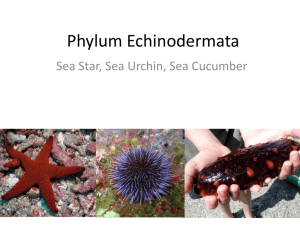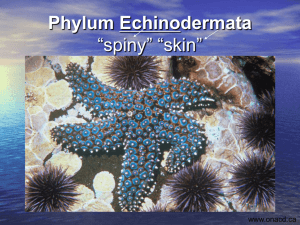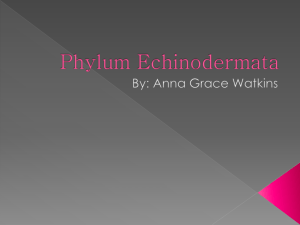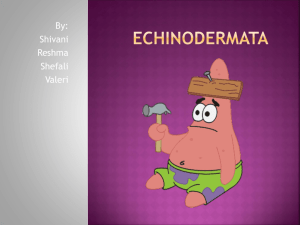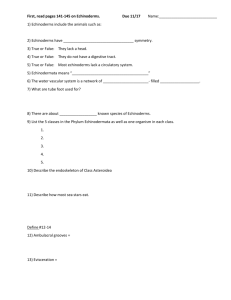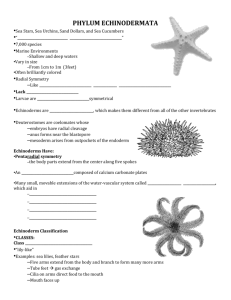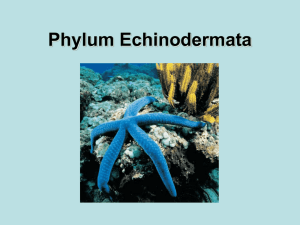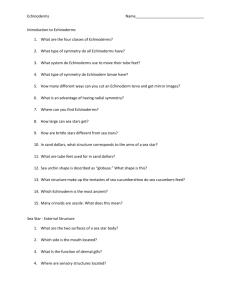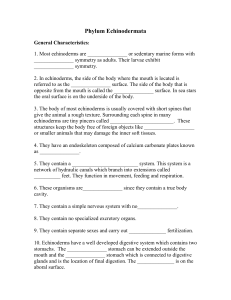Sea Cucumber
advertisement
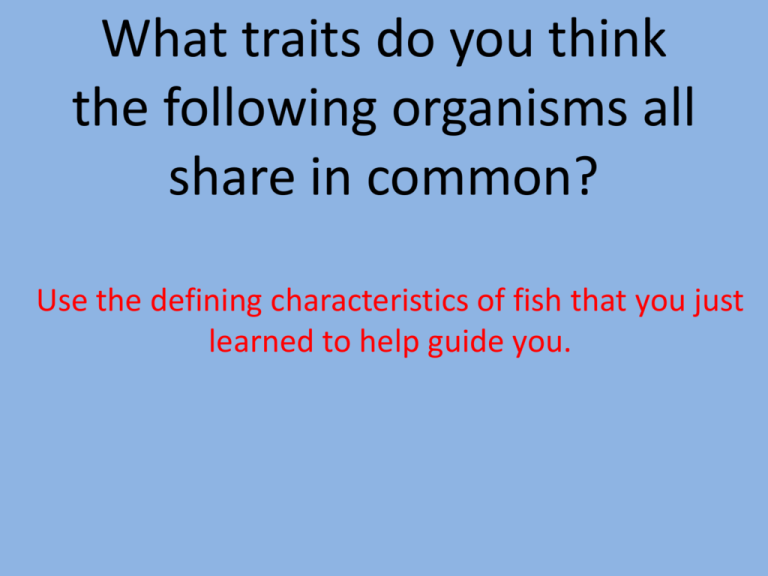
What traits do you think the following organisms all share in common? Use the defining characteristics of fish that you just learned to help guide you. Sea star Sea urchin Sea cucumber Sand dollar Brittle star Invertebrates: • Kingdom: Animalia • Phylum: ???????????????? We are now going to look at several other phyla as we move through the end of the course that are still grouped in the animal kingdom, but lack a spinal chord (invertebrates). Echinoderms – Stars of the Sea -Kingdom: Animalia -Phylum: Echinodermata Echino = spiny Derm = skin Echinoderms – Stars of the Sea -At first glance, it may be impossible to group the various forms of echinoderms together. -Examples: Sea stars, sea urchins, crinoids, brittle stars, sand dollars, sea cucumbers. -They can all look extremely different, but with a closer look they actually possess many similarities. Echinoderms – Stars of the Sea -The major characteristic that all echinoderms have in common: 1) Body has no segments (this is a common distinguishing characteristic for any invertebrate) Echinoderms – Stars of the Sea -The major characteristic that all echinoderms have in common: 2) Radial symmetry – divided into 5 parts 1 5 2 4 3 •Every arm has an equal share of the animal’s systems! Echinoderms – Stars of the Sea 3) Water vascular system – water suction system for moving around/self-defense (almost like hydraulics) tube feet *Most have tube feet pedicellaria Echinoderms – Stars of the Sea 4) Ossicles (a.k.a. test) – a solid “skeleton-like” structure that makes echinoderms rigid. *They are made of calcium carbonate (like sea shells) and have different shapes for each class of echinoderm. Provides stability and protection. Echinoderms – Stars of the Sea 5) Dermal Branchia – Respiration/gas exchange. These are small soft lumps on the exterior of the body that absorb oxygen for respiration. Oxygen from water Echinoderms – Stars of the Sea Reproduction – can be asexual or sexual. *asexual = regeneration of limbs •Every arm has an equal share of the animal’s systems!!!! •They can regenerate arms!!! *Sexual = free spawning Echinoderms – Stars of the Sea -Sea stars actually have an “eye” at the end of each arm called an ocellus. -It allows them to recognize light and dark areas, not actually see figures. -Their other main senses are taste (with mouth parts/chemical receptors) and feel (with nerves near tube feet) -So closely related to chordates (us) because their development stages are very similar to ours! All other marine invertebrates Us and echinoderms 1)We are both dueterostomes (first embryonic opening, or blastopore, becomes anus). 2)In all other sea organisms, it becomes the mouth (protostomes) 3)We both have bilateral symmetry during developmental stages. -Thus, sea cucumbers are our closest relative in the sea (other than the vertebrates) -Echinoderms are often times used as an “indicator species” in marine environments. Army of sea stars -They play an important role in shallow water ecosystems, so their presence or absence usually tells scientists how healthy the ecosystem is. A healthy balance of these 2 pictures represents a healthy ecosystem. An overgrowth of kelp means the water is not healthy enough to support urchins. (urchins eat the kelp) An area with no kelp means the water is healthy, but something is wrong with the otter/sea star population. (otters/stars eat urchins) SKETCH 1 – Label the arms, ocelli, and madreporite. Also, describe function of the madreporite. Eyespot (ocellus) Tube feet SKETCH 2 – Draw the ventral side of the starfish, including the labels above. SKETCH 3 – Open the starfish on the dorsal side. Label the circled parts of the internal anatomy. SKETCH 4 – Draw a picture of JUST the water vascular system. Label all circled parts of the anatomy. Explain the function of the water vascular system below the sketch. Analysis • List 5 characteristics of the starfish that you expect to see tomorrow during the sea urchin dissection. Move using extended tube feet Sea Urchin Spines can cause painful, infected stings (few are venomous) Gonads are a delicacy in some cultures. Eat using mouth parts called “Aristotle’s Lantern” SKETCH 1 – EXTERNAL VENTRAL SIDE (you will see the mouth, spines, and pedicellaria) SKETCH 2 – EXTERNAL DORSAL SIDE (you will see the anus and madreporite) SKETCH 3 – carefully cut an opening on the side of the urchin. (be careful cutting around the sharp spines). Once you open the urchin, first draw the digestive and reproductive organs. -Stomach/Intestines (brown on the diagram) -Reproductive glands (pink on the diagram) SKETCH 4 – Now draw the water vascular system (blue on the diagram). Water travels in through the madreporite, travels down through the stone canal into the ring canal, and finally gets moved through each of the 5 radial canals where water is pumped into and out of tube feet to move the urchin along the sea floor. SKETCH 5 – Aristotle’s Lantern With the urchin open, remove the solid tooth-like organ directly above the mouth. This is actually 5 separate teeth surrounded by muscle that the urchin uses to chew. This organ is known as Aristotle’s Lantern. Draw the mass. List 5 characteristics of sea urchins that you expect to see on Tuesday in the sea cucumbers. Sea Cucumber Radial Symmetry -Sea cucumbers are essentially elongated urchins without the spines. -The are widely dispersed and have been found in every area of the ocean floor. -They can extrude gonads and other internal organs through their anus as a self defense mechanism. (allow predator to eat these organs or sometimes they are sticky and trap the predator to avoid being eaten). Over 2,500 species have been discovered with a huge variety of colors, sizes and appendages. Sketch 1 – External anatomy. Sea cucumbers are just elongated sea urchins without the spines. You will see tube feet for transport just like the urchin. They have a continuous digestive system with a mouth inside a group of tentacles and an anus at the other end. Find the madreporite, where water is pulled into the water vascular system. Madreporite The tentacles are just modified tube feet to help snatch small prey. Sketch 2 – reproductive These are the organs that the cucumbers can push out to distract or trap potential predators. The gonad will take up more space than the picture displays. Label the gonads and then remove them to reveal the other internal organs. Label the pharynx (throat), stomach, intestines, and anus Sketch 4 Water vascular system Behind the reproductive and digestive organs you will find the water vascular system. As with the other echinoderms, label the madreporite, stone canal, ring canal, radial canals, and tube feet. There was no mention of any ossicle (skeleton) in this echinoderm dissection. They do have an ossicle, how do you think it might be incoroporated into their body structure? It is made of thousands of tiny individual microscopic parts.

